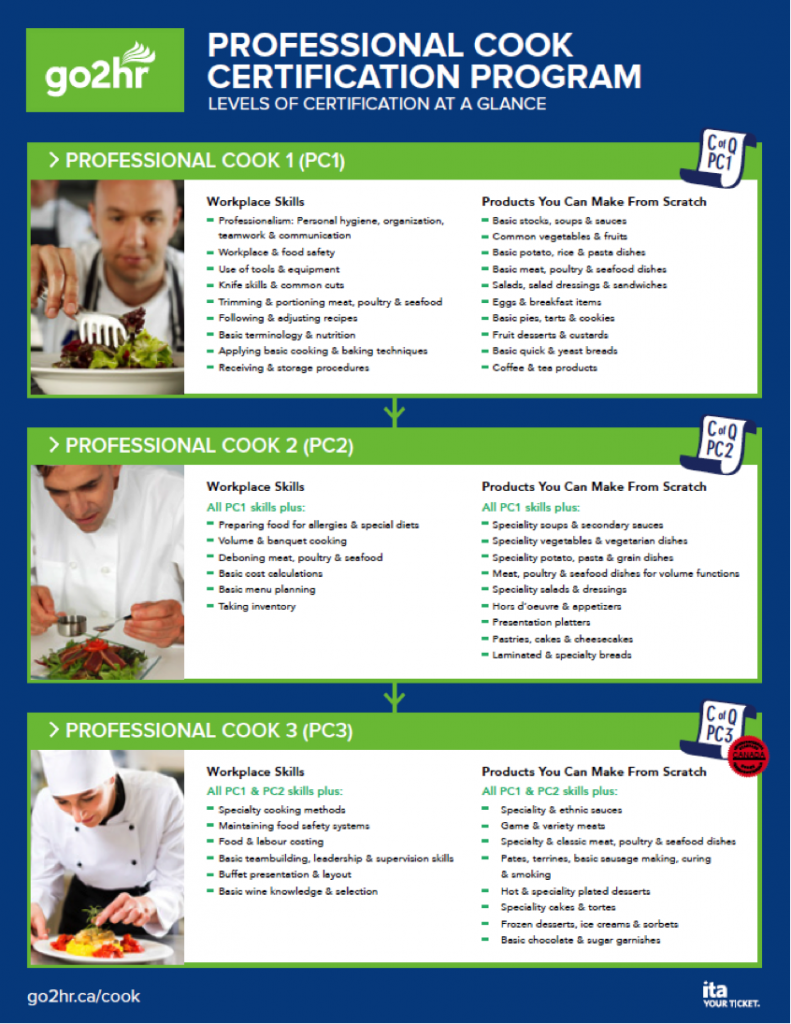8 Training and Certification
The traditional way of advancing in the hospitality industry was to get an entry-level position and then work your way up to more skilled positions almost solely based on your work experience and learning from others. Today, formal training at a college or trade school is often needed if you are to advance in your chosen career, particularly if you wish to advance into supervisory or management positions. This training might be a post-secondary certificates, degree, or diploma; apprenticeship training; and industry certifications.
In any case, the industry still tends to promote people from within, and even with formal training, most people will start in entry-level positions and then work their way into positions with higher levels of responsibility over time. Advancement in the industry follows a logical series of progressive steps as you gain more experience, which is often referred to as the career ladder (Figure 1).

Post-Secondary Training
Many public and private colleges and trade schools, and also some high schools, offer training in the industry for both the culinary professionals and those looking for training in front of house occupations like bartending or wine service and hospitality management. Most post-secondary programs group training into certificates, diplomas, and degrees, based on the number of courses and length of time it takes to complete. Many of these programs also ladder into other training such as apprenticeship or industry certifications.
Apprenticeship Training
Apprenticeship is a system of training that has been around for hundreds of years. Before there were trade schools and colleges, if someone wanted to learn a trade that person would seek out an experienced tradesperson (called a journeyperson or master, depending on the level of experience) and learn the trade by working with the tradesperson until he or she had developed enough skill to perform the job alone. This system has evolved to include formal training at a college or trade school, but still has two main components: practical training (practising techniques and procedures while producing products) and technical training (learning new skills). Practical training is achieved on the job, supervised by a certified journeyperson, and technical training is delivered by accredited institutions.
In British Columbia, all apprenticeship and trades training falls under the authority of the Industry Training Authority (ITA). For a full list of ITA programs and certifications, visit the ITA website at www.itabc.ca.
For trades that are offered in multiple provinces, the national Red Seal program is available, which is a national endorsement that is added to provincial qualifications upon the successful completion of the interprovincial Red Seal exam. There are 57 Red Seal trades in Canada, including Cook and Baker in the food service industry. For more information on the Red Seal programs, visit www.red-seal.ca.
In British Columbia, there are three levels of certification available through apprenticeship, as shown in Figure 2.

With the various certifications, there are a number of options for working in the industry, as outlined in Figure 3. For more information on the certification and career options at each level, visit https://www.go2HR.ca/training/apprenticeships.

Industry Certifications
emerit
The Canadian Tourism Human Resource Council (CTHRC) offers training and certification in over 40 tourism occupations from front line to management level, under the emerit brand. For a full list of training options, visit emerit‘s website at www.emerit.ca.
Canadian Culinary Federation certifications (Canadian Culinary Institute)
To progress beyond a provincial or Red Seal certification requires further training coupled with on-the-job experience. Much of the training is presently on an informal basis, but there are certifications offered by the Canadian Culinary Federation (CCFCC), Canada’s national occupational association for cooks and chefs, designed to fill this gap.
The CCFCC has three programs designed to certify chefs: the Certified Working Chef (CWC), Certified Chef de Cuisine (CCC), and Certified Master Chef (CMC). Candidates must take theory courses followed by written and practical examinations. Course components include theoretical and practical seminars and self-paced learning packages. For more information see the Canadian Culinary Federation website: www.ccfcc.ca.
In summary: There are many options, but the example below shows the different types of training and certification available in Canada for the culinary arts, and how they relate to each other. The interactive career map is available from the Canadian Tourism Human Resource Council.
Wine training and certifications
Additional certifications for restaurant staff include internationally recognized wine service certifications such as the Wine and Spirits Education Trust (WSET) courses and those offered by the International Sommelier Guild.

